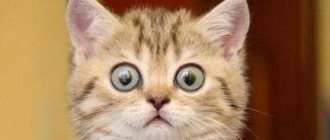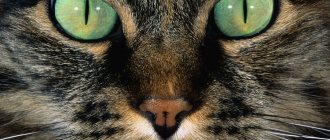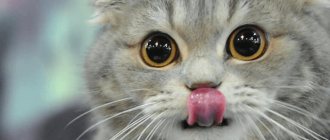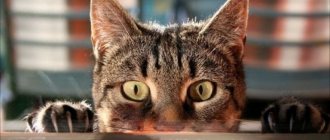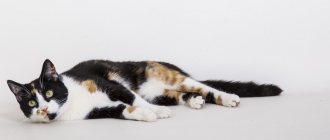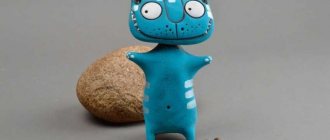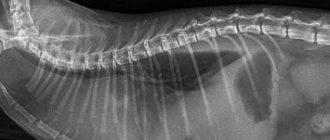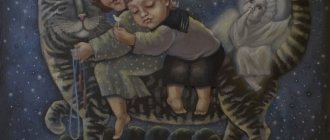Description of the cat
The body sizes of cats and cats, on average, are about 30-60 cm in length and 20-30 cm in height. The weight of the animals fluctuates around 3-7 kg. However, the largest representatives of domestic cats have body sizes exceeding the meter mark, and their weight easily exceeds 10 kg.
The color of cats has a huge variety, including more than a hundred colors and shades. Moreover, the coat color of pets can be mixed, and may include patterns that stand out in color. Therefore, it is extremely difficult to find two animals that are absolutely similar in color, even if only slightly, but they will differ.
By the way, the most common colors of cats are light or light gray, red or light brown, dark gray, dark brown and black.
1) How to care for a cat and dog?
Cats and dogs are man's best friends. They definitely need to be looked after. Feed, water, clean, sometimes bathe, comb the fur. Dogs must be walked twice a day. You need to play with these animals as much as possible.
2) Look at the photographs. Tell me how these dogs serve humans
Dogs can be not only friends to humans, but also helpers. They can work as guides for blind people, or be sled dogs. Sled dogs are often used by residents of the north.
3) Using the identification atlas, name several dog breeds
Breeds: dachshund, dalmatian, poodle, shepherd, collie, boxer, pug, bulldog, husky, greyhound.
Habits of cats
Cats are carnivores, being small predators. At the same time, they can eat plant foods, but they still cannot do without meat. Their diet in the wild consists of small mammals (especially rodents), amphibians, amphibians, fish, birds and insects. However, pets usually do not neglect hunting animals, even if they have plenty of food.
Interestingly, cats sleep most of the day, usually from 12 to 16 hours a day. Some breeds can spend up to 20 hours in a sleepy state, and small kittens even sleep up to 23 hours a day. Animals spend the remaining time searching for and eating food, grooming themselves, playing and having fun.
By lying on their backs, cats show their trust in humans. And lifting your tail up - your love. If a pet wags its tail, this means doubt, difficulty in choosing. They meow only to people, attracting human attention. And they express their pleasure by purring or spreading their fingers. Animals demonstrate their fear with raised fur and flattened ears. However, even identical gestures do not always carry the same meaning, especially among different felines.
№14
Many saw rescuers removing cats from trees. And it would seem surprising that they easily climb trees, but cannot get down from them. The explanation is very simple. The thing is that their claws are curved back. They help to deftly climb trees, but do not allow them to descend. Most cats jump from trees, and those that cannot do so wait for help from humans.
Facts about cats
Cats are the most common pet in the world and are universally loved for their highly social behavior.
Domesticated cats bring great benefits to people by exterminating and repelling rodents (mice and rats, mainly). By the way, if they cannot catch prey, they begin to chatter their teeth, showing their dissatisfaction and irritation.
Cat claws are slightly curved, so the animal can easily climb onto various surfaces. But it’s difficult for cats to get down from them. But they can easily jump, surviving even after falling from a height of 30-40 meters.
Cats live 4-5 times less than people, about 15-20 years, and their record life expectancy is 39 years.
№6
Scientists still haven't figured out why they meow. The fact is that small kittens meow for their mother, which suggests that this is how they communicate. But when they become adults, they don't meow when interacting with other cats. They only meow when interacting with humans. Therefore, scientists still cannot understand this phenomenon.
Fact 5. If my head goes through, I can get through it all
A cat uses its whiskers to determine the volume of space around it, namely whether it can squeeze into a given space.
And she can squeeze into any hole that her head can fit into, because... The cat does not have collarbones, and the head is its largest bony organ.
Verbal portrait of a dog for 2nd grade
My grandmother has a dog. This is a cross between a shepherd and a mongrel. She is slightly smaller than a shepherd, but much larger than ordinary mongrels. Her fur is red with black and white spots, not very long, but thick. Twice a year she sheds and then she has to be brushed frequently, removing old hair. She has a small but thick tail, which she likes to hit furniture with.
A dog's claws are black and thick; they do not retract like a cat's, and therefore are not as sharp.
The dog has short ears that always stand up in a column, black eyes and an always wet nose. She is very kind and sociable. My favorite weighs more than 30 kilograms, so you can’t pick her up.
Extracurricular activity about cats, 3rd grade. Abstract with presentation
Extracurricular lesson in 3rd grade on the topic “Diversity of cat breeds”
Description of the material: I bring to your attention an extracurricular lesson on the topic: “Diversity of cat breeds” for third grade. This topic is studied during the course “The ABCs of Animal Keeping”, in the section “Cats that don’t walk on their own.” The content corresponds to the approximate program of extracurricular activities, educational complex “School of Russia”, direction: general intellectual. This lesson can be carried out not only in extracurricular activities, but also in lessons about the surrounding world, if it corresponds to the content of the lesson topic. Each teacher can interpret this work for both 4th and 2nd grade, adding tasks or reducing the number of existing ones. During the lesson, a presentation created in PowerPoint and handouts presented in Microsoft Word are used. Preparing for the lesson requires special attention, but I am attaching the materials for this. Goal: to create conditions for getting acquainted with the varieties of domestic cat breeds. Objectives: Educational:
- consider the appearance of various breeds;
— study the features of cat care depending on the breed; — determine the origin of the breed; — consider the character traits of different breed cats. Developmental:
develop the ability to work in groups, express and argue your point of view, listen to and accept someone else’s;
develop the ability to work with templates, diagrams, images and other reference materials; develop logical thinking (analysis, comparison, synthesis); develop the ability to carefully create an applique and use tools (glue). Educational:
to cultivate a value-based attitude towards pets, to instill the basics of caring for pets at home.
Progress of the lesson
(Before the start of the lesson, the teacher arranges desks for group work and determines the lists of students in each team. There should be a total of 6 teams. When adjusting the content of the lesson, the number of teams may change) Teacher: Good afternoon, dear guys! Today we will work in groups, as you already understood, so for the work to be successful, let's greet each other. Wave to your neighbor across the street. Now smile, high five, and shake hands. So we can get started with smiles on our faces! (The teacher lays out envelopes with cut-out images from Appendix 1, one per team. On top, the envelopes should be numbered from 1 to 6. This is necessary to check the correctness of the task) Teacher: In order to understand what the topic of our lesson will be, please open envelopes that lie on your tables under numbers. Look, inside are parts of one whole. You need to collect an image. (Students complete the task in teams) Teacher: What is shown in the picture? Students: Cat! Teacher: Did everyone get a cat? Let's check. Go to the board, click on your envelope number and compare the images. (A slide with 6 numbers appears on the interactive board. Under each number there is an image of a cat. It appears when you click on the number and corresponds to the image in the envelope. One group member at a time, students go out and check the task)
Teacher: Look, everyone got cats, but are they the same? Students: no! Teacher: Why are they different? Students: Because cats are different breeds. Teacher: Who guessed what the topic of our lesson would be? Students: cat breeds/variety of cat breeds. (A slide is displayed as confirmation)
Teacher: state the purpose of the lesson. (Students offer options for formulating the goal. The teacher leads to a single one)
Teacher: In order not to miss anything, let's make a lesson plan. Look at the slide.
Teacher: The plan fell into halves. Let's connect the points of the plan and restore it. (Students perform tasks on the interactive whiteboard. Triggers are configured on the slide. A trigger is an object on the slide (inscription, shape), when clicked, the animation of one or more objects is launched. Therefore, the plan is drawn up as follows. Study the parts of the plan and imagine what should be connected. The teacher must know the correct answer in advance. Then click on the halves that are on the right. They will automatically connect with the desired item and form a whole element)
(Next, the teacher distributes breed passport templates to each team (Appendix 2)) Teacher: I distributed the templates to you, tell me what they are? Students: passport. Teacher: As you noticed, it is empty. Today in class we will create a passport for each breed together. Each team will be able to contribute to the creation of each passport, a little later we will find out how. You have already collected the images. Please paste them onto the cover. (Next, throughout the lesson, the teams will pass passports to each other in a circle. Each team will add one element. As a result, the team should return a completed passport with the image of the breed that they pasted in. As the lesson progresses, I will demonstrate the stages of creation to clarify , what should happen in the end)
1.
Teacher: Now give your passport to the team on the right. Look at the image. We know what this breed looks like, now let’s figure out what it’s called. Now I will distribute 6 descriptions to each team. Only one is suitable for your cat. You need to choose a description and determine the name of this breed. (To complete the task for students, the teacher distributes 6 cards with descriptions to each team (Appendix 3). The presentation does not check this task, so the teacher verbally controls the correctness of its completion) Teacher: Well done! Correctly identified! Turn your passport over and paste the text into the “appearance” section. Now write the title on the cover in large, beautiful letters, without errors. And give your passport to the team on the right. 2.
Teacher: Look, we missed the origin point, so let’s move on to it. There are 6 flags of different countries on the board. Only one of them describes the origin of your breed. Look at the picture of the cat. Now a puzzle will appear on the slide, you will need to follow the lines with your eyes and understand which country’s flag your cat belongs to. I turn it on. (The teacher attaches 6 flags from Appendix 4 to the board. (Two will be the same) A slide appears. Students complete the task on the slide and select the one they need from the board. Then, the teacher clicks on the presentation again, the images begin to move and the correct solution is displayed)
Teacher: Check if you brought the correct flag to the team. If it’s correct, paste it into the “origin” section; if it’s wrong, exchange it with another team and paste it in the same way. Pass the passport to the next team. 3.
Teacher: Character. This is probably the most interesting thing about a cat. How can we understand the character of a cat? On the slide you will see keywords, they are also found in cards with descriptions. You need to find the correct description using keywords. (The teacher distributes cards with descriptions of 6 characters of different cats (Appendix 5). Students complete the task. There are key words on the slide. It is by them that you need to find the correct one. There is no check on the slide, the teacher checks the correctness of the task orally using the key words)
Teacher: Read the description, and we will check if it contains the keywords that are presented on the slide. Well done! Attach the information to your passport in the “character” section. 4.
Teacher: In order to find out about care, I’ll tell you a secret, re-read the description of appearance. There is a number hidden in the text, find it. She will tell you the card number under which the care rules are hidden. Select the one you need from the list, read and attach. Give your passport to the neighbors on the right. (There is actually a number hidden in the description of appearance. This is the number of the card (Appendix 6), which describes the care of this breed. Thanks to this task, we will distract students from the intellectual load and contribute to the development of vigilance)
5.
Teacher: The finished passport has reached you, but before it returns to the hands of the team from which it started, read it. And come up with 3 questions about this breed. Write them down on the back of your passport in the free space. Pass it on. (The teacher walks between teams and checks the correctness of the questions. After checking, he orders them to be transferred to neighboring teams) Teacher: Now let’s summarize the information received. Read everything that is written in the passport, including questions. And prepare a passport defense (a few sentences about this breed) and demonstrate it. 1-2 minutes to speak, 3 minutes to prepare. Get started. (Projects are defended, after which the teacher evaluates the performances, corrects, makes comments and praises the students) Teacher: You have worked with all the breeds, tell me which one did you like the most? Why? At the beginning of the lesson we made a plan, let's go back to it and check whether we have completed all the points of the plan. (Using the presentation, students check the points of the plan. If the point is completed, click on it, a check mark will appear next to it, and so on with all three) Teacher: Having followed your work in class, I can safely say that you can be called cat experts, therefore you get a badge to prove it! (Appendix 7) Teacher: Now you will evaluate your work in class. Continue the phrases from the slide.
Teacher: Thank you for your activity and interest.
Thank each other, your teams did a great job, now these passports will decorate our classroom corner. The lesson is over. Presentation on the topic: Diversity of cat breeds
Applications for work
We recommend watching:
Possibilities of gaming technology for the formation of communicative and regulatory UUD in classes on external education Extracurricular activities in the 3rd grade on the topic: Healthy lifestyle, Synopsis Abstract of an extracurricular creative lesson for schoolchildren in grades 3-4 with a presentation Extracurricular activities for grade 3. Topic: My family. Abstract with presentation
Similar articles:
Summary of an extracurricular lesson on Safety Fundamentals for students in grades 3-4
Role-playing game for younger schoolchildren. Plant properties

